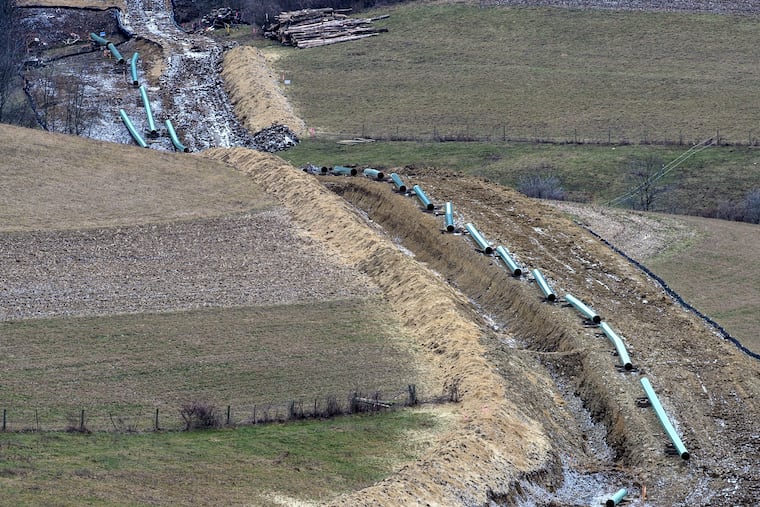Delaware County pipeline study finds risk less than fatal car crash, house fire
The study, first proposed in January, measures the danger presented to residents by Mariner East 2 and Adelphia Gateway.

A long-awaited study of two pipelines planned for Delaware County found that the risk they present to residents is in line with those of other common hazards.
The report by G2 Integrated Solutions found that residents living directly adjacent to pipelines are 20 times more likely to die in a traffic accident than to be killed by a rupture of the Mariner East 2 pipeline, or 27 times more likely than to be killed by the Adelphia Gateway pipeline. Fatal house fires and falls down the stairs are also more likely than deaths from the pipelines, according to the study.
Mariner East 2 is part of Sunoco Logistics' $5.1 billion effort to transport natural gas liquids from Western Pennsylvania to the Marcus Hook refinery, and is expected to be fully installed and in operation in the coming months. Adelphia Gateway LLC's eponymous line is already installed in the county — the project would repurpose a hybrid oil/natural gas pipeline to ferry natural gas from Northampton County to Marcus Hook.
The full results of the study will be presented by analysts from G2 at a hearing organized by the County Council. No date has been set, but officials estimate it will convene sometime in the next few weeks.
It's a conversation more than a year in the making. In January, then-newly elected County Councilmen Kevin Madden and Brian Zidek began pushing for an independent risk-assessment of the pipelines. For months, the two Democrats were blocked along party lines by their GOP colleagues on the council.
Debate raged over the necessity of the study, and whether any engineering firm would be able to provide a truly objective analysis. Finally, in July, the council came to a consensus, hiring G2, headquartered in Texas, to complete the $115,000 assessment.
Lisa Dillinger, a spokeswoman for Sunoco parent company Energy Transfer Partners, said Monday that the company was pleased the G2 study "supports what we have been communicating all along about the safety of the Mariner East 2 pipeline." A spokeswoman for Adelphia Gateway did not respond to a request for comment.
G2 used publicly available data from the respective pipeline companies, as well as historical data from Pipeline and Hazardous Materials Safety Administration to "estimate the frequency of an initiating release event" for the pipelines.
Now, proponents on both sides of the natural-gas pipeline debate are wielding those results as justification for their positions.
Eric Friedman, a spokesman for Del-Chesco United for Pipeline Safety, highlighted an estimate from the G2 study that showed a worst-case scenario of a Mariner East 2 rupture in which a flammable vapor cloud could extend 1.3 miles.
"It is now abundantly clear that the rupture of a hazardous, highly volatile liquids transmission pipeline in Delaware County is going to be a mass casualty event," Friedman said. "And the odds of this happening are disturbingly high. Del-Chesco United for Pipeline Safety calls on Delaware County Council to take action now based on the alarming public safety implications in this report."
This summer, Del-Chesco United crowdfunded its own study of Mariner East 2 and its sister pipeline, hiring Quest Consultants, a firm the county council balked at using for its own analysis because of its work for the citizens group. The Quest study found that the odds of a resident of Delaware or Chester Counties who lives near Sunoco's Mariner East pipelines dying in an explosion from those lines are about one in 81,000. For context, that's a probability sandwiched between dying in a car crash (one in 8,513) and from complications in a medical procedure (one in 125,000).
Friedman also pointed out that G2's study doesn't include the multiplier effect that Quest's did — in other words, the risks presented by the pipelines double in some areas where more than one pipeline is present. He also noted that if either Mariner East 2 or Adelphia were to rupture, the subsequent explosion or fire would injure multiple people in the densely populated county.
But Kurt Knaus, a spokesman for the Pennsylvania Energy Infrastructure Alliance, hailed the G2 report as vindicating the embattled pipeline projects.
“Today’s report confirmed what we have long known — that pipelines are the safest, most efficient means of transporting Pennsylvania’s energy resources,” Knaus said. “Living near the Mariner East lines is actually safer than driving a car, and this report confirms that local residents needn’t fear this critically important infrastructure project that will deliver significant economic benefits to Pennsylvanians for years to come.”